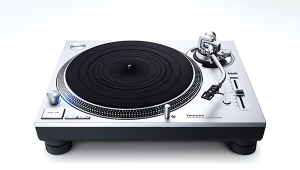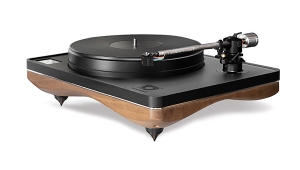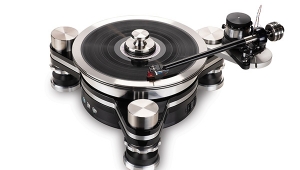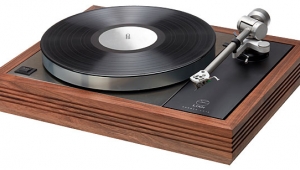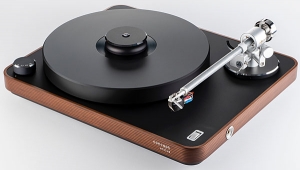| Columns Retired Columns & Blogs |
SME Model 20/12 turntable & 312S tonearm Page 2
What I wrote in 2003 of the Model 30/2's build quality and fit'n'finish is also true of the 20/12: "The machining quality of the proprietary setup tools and the smoothness and unfailing certainty with which the various locking screws rotate in their threaded sockets—not to mention the feel of the unlocking mechanisms—enhanced my confidence that the buyer's money will be well spent. The 30/2 is an heirloom product meant to be enjoyed and passed down from generation to generation."
No-nonsense engineering
Because playing records is all about turning mechanical into electrical energy, the control and damping of vibrations, as well as efficient energy transfer, are the keys to any successful turntable design. If the machining of the bearing is very precise and the construction of the plinth is rigid, dense, well damped, and effectively isolated, the turntable shouldn't produce appreciable noise of its own.
The SME 20/12's ¾"-diameter spindle, precision-machined from hardened and ground high-chrome steel, rides on a conventional ball/thrust pad that floats in a sealed oil bath. Technically, it's as conventional as it gets; its superb performance relies on precise machining—something SME knows how to do well.
Though measuring only 20.5" wide by 14.8" deep, the 5/8"-thick aluminum-alloy subchassis, suspended by 10 specially designed O-rings for each of the four towers, weighs 17.6 lbs. SME claims the design is stiff enough to avoid low-frequency torsional flexing and sufficiently well damped to avoid high-frequency resonances, and that the suspension effectively isolates low-frequency energy from feeding back into the system.
With the motor located on the lower, fixed subchassis and the platter on the suspended upper chassis, there's the possibility that upper-chassis horizontal deflections caused by tonearm undulations (particularly when playing eccentrically pressed LPs) can vary the distance of the motor pulley from the platter and thus affect speed accuracy. SME addresses this so-called "porch glider" effect with a centrally located fluid damping system, while the outboard power supply's microcomputer-controlled, closed-loop, pseudo-sinewave commutation sequence and proportional-plus-integral (PI) algorithm oversees control of the motor's three speeds (33.33, 45, and 78rpm). The motor itself is a triple-phase, six-pulse, inductance design with an eight-pole neodymium magnet structure and three integrated Hall position sensors. The net result is effective motor isolation and precise control of motor speed.
SME 312S 12" tonearm
Only a few tonearms with which I'm familiar can match the rugged build quality and precise fit'n'finish of an SME arm. It's safe to say that while some others are built as well as the 312S, none is built better. Setting up any SME arm is particularly fast, convenient, and just about foolproof, though the ones with detachable headshells, like the 312S, are even easier.
SME began making 12" tonearms almost from the time it began making record players, with the Model 30/12. Most 12" arms were originally used in radio stations, where their extra length made possible playback of 16" transcription discs pressed at 16.67 or 33.33rpm. The longer arms soon found their way onto audiophile turntables. But before addressing the 9" vs 12" tonearm controversy, let's look at the 312S.
The 312S has a tapered armtube made of pressure die-cast magnesium, 27gm lighter than if it were made of aluminum. Magnesium gives the tube strength, rigidity, and low mass—all keys to getting good performance from a longer tonearm.
Fitting the tube with a detachable, rigidity-reducing headshell would seem to be counterproductive, but SME has come a long way from the its old-fashioned, floppy bayonet mount, to a spring-loaded system that's both mechanically and electrically secure. While this has the advantage of permitting quick changes of cartridge and adjustment of azimuth, it has the disadvantage of adding two more electrical breaks between the cartridge pins and RCA plugs, for a total of three.
SME reprises the familiar, ultraconvenient, and secure sliding-track overhang adjustment mechanism for the arm, the less-than-convenient (for fetishists) spring-loaded VTA post, the underslung counterweight, the high-quality, low-tolerance bearings—and, most important for a 12" arm, the silicone-filled damping trough with adjustable paddle.
Foot-long arms have been extremely popular in Japan for many years, and lately their popularity elsewhere seem to be growing—but is that only the herd mentality at work? Anyone who tells you about the superiority of 12" tonearms without addressing the tradeoffs involved is blowing smoke. Yes, there will be lower horizontal tracking error and therefore less distortion—but how much lower error, how much less distortion? And at what cost?
Looking at the geometry of a pivoted arm, obviously, at the Baerwald null points of 120.9mm and 66mm from the spindle center, the stylus will be tangential to the groove, and there will be no tracking error with a properly set-up arm of any length. Comparing, for instance, SME's nominally 9" 309 arm with the 312S at the 146mm point across the groove surface, the misalignments from tangency are +1.86° and +1.35°, respectively (see the diagram). Closer to the end of the side, at 89mm, the respective errors are –1.1° and –0.79°; even closer, at 60mm, the misalignments are +0.76° and +0.56°. So, yes—the longer arm produces less tracking error. But does that translate into lower audible distortion? And what other variables need to be taken into consideration?
Reducing all of the numbers to something easily understandable, and using the Baerwald alignment, the tracking error of a nominal 9" tonearm (229.7mm effective length) produces levels of harmonic distortion that max out at around 0.65% over about 25% of the groove surface, this rising to about 0.8% for the innermost grooves. The tracking error of a nominal 12" arm (effective length 309mm) produces harmonic distortion that maxes out at around 0.46% over the same 25% of the groove surface, and at about 0.5% for the innermost grooves. That's it: 0.65% and 0.8% vs 0.46% and 0.5%, and those percentages hold true with precise alignment. Setup errors with a longer tonearm will be magnified, potentially narrowing the gap even more.
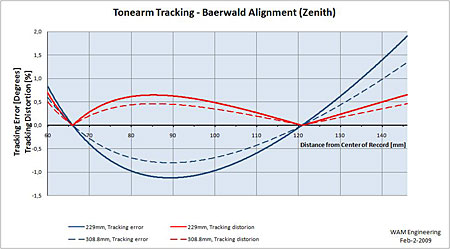
Other big issues to consider are a longer arm's mass, rigidity, and dynamic behavior. In the case of the 312S, SME has managed to keep the mass low and the rigidity high. The difference in mass between the 312S and SME's 9" arms is insignificant in terms of calculating tonearm/cartridge resonant frequencies (9.5 vs 12gm), which, for a 10gm cartridge of low to medium compliance, translates into 10Hz vs 9.5Hz. However, for 12" tonearms that are much heavier than their 9" counterparts, the difference in mass could be significant, as the effective mass or moment of inertia is calculated by multiplying mass times the distance to the pivot squared; those extra inches add up fast.
- Log in or register to post comments
